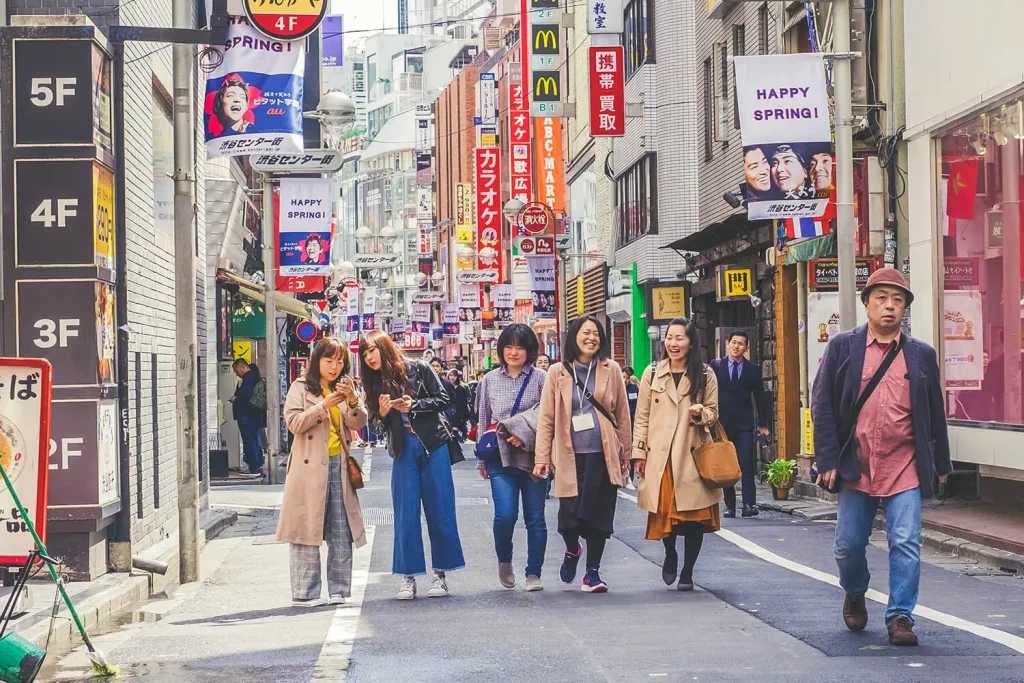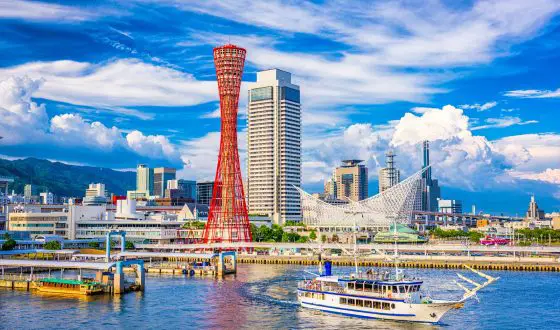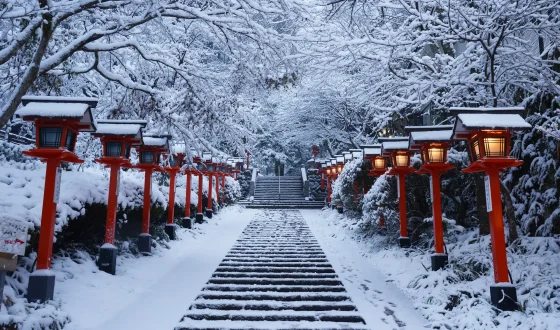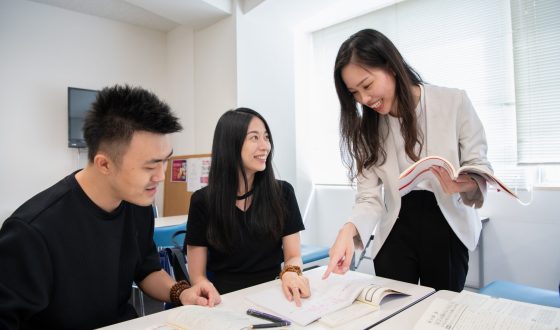What To Wear in Japan in November? A Comprehensive Guide
Japan is rich in culture and tradition, so packing appropriately for the destination is essential. Autumn is one of the most perfect times to go and here we have advice on what to wear in Japan in November, whether you’re planning a trip to the busy hub of Tokyo or a more rural getaway to the Japanese Alps.
1. The weather conditions in Japan during November
November: High 17.4℃ (63.2°F)/ Low 9.8℃ (49.4°F)
November days typically turn cooler. There may be days when you also require a coat and possibly even a scarf, depending on the temperature. When traveling in November, it’s a good idea to be a little bit over-prepared because the weather can change significantly throughout the day.

Depending on the weather, there may be days when you also need a coat and perhaps even a scarf. (Source: Internet)
2. Packing checklist for Japan in November
- A packable waterproof jacket.
- High-quality, well-worn walking shoes (thank us later).
- Lightweight merino wool layers (think light wool crew necks, merino cardigans, and high-wool blend wraps).
- Mid-weight pants, comfortable enough to walk around in. (Not too stiff or uncomfortable, you will be walking a lot).
- Some dressy outfits for going out in the evenings.
- A pair of dressy shoes that goes with all of your dressy outfits (e.g. black ankle-length dressy boots).
- A mid-sized backpack to carry your travel essentials.
Optional:
- A travel umbrella
- Hiking shoes if you plan to take part in hiking tours
3. What to wear in Japan in November?

What to wear in Japan in November? (Source: Internet)
3.1. Coat and jackets
The cold weather in Japan is becoming more intense every day as November serves as a preparation for the impending winter season. A light coat or denim jacket should be at the top of your packing list to keep you warm during your frigid excursion.
In November, which has 12 of the month’s 30 days with precipitation, you need to be ready for downpours. When traveling in the autumn, you will be constantly on the go, so be sure to dress in a waterproof coat or jacket.
Bring a waterproof garment or coat with you for areas of Japan like Mount Fuji where you might get wet. If at all feasible, dress in a packable jacket, which can be quickly folded, stored in a bag, and then quickly retrieved when necessary.
3.2. Walking shoes and boots
Walking is required to explore Japan’s beautiful autumnal foliage in November. Wear dependable shoes so you can stroll the streets for hours on end.
On a walking expedition, you wouldn’t want to develop blisters, would you? Make sure the sole of your shoe has suitable cushioning softness. For a comfortable walk, wear lightweight footwear.
If you visit Japan in November, you may need to dress for cool fall evenings by donning a pair of heavy boots and warm socks.
3.3. Wool layers
Carry many layers of wool clothing for protection in Japan during the chilly autumn evenings. Use a thick sweater and layers of clothing to prevent the intrusion of cool air and to stay warm inside. The cold weather of this season is ideal for an additional layer of a Merino wool sweater.
3.4. Gloves and hat
You could pack some gloves and a hat in your luggage just in case when the average temperature in Japan drops in November and the jacket isn’t enough to keep you warm.
3.5. Comfy pants and jeans
It is uncomfortable to navigate the country’s streets in tight long pants or jeans. Wear loose-fitting attire on your trip to Japan. The material of the long pants ought to be thick enough to keep you warm during the chilly fall months.
3.6. Dress and shirts
Dresses and t-shirts appropriate for Japan’s autumnal climate. Leggings with a thick fabric can be worn with dresses to complete the look. While it’s acceptable to wear a T-shirt, it’s preferable to use long sleeves as additional layers to protect against the chilly weather, especially at night.
3.7. Mid-sized backpack
Make sure to include a backpack on your list of things to bring to Japan. Bring a medium-sized backpack with you that can hold the essentials you’ll need for the trip, such as foldable jackets, a first aid kit, a phone, a charger, a small umbrella, makeup, and toiletries.
You can also like:
- 8 Highest Paying Jobs In Japan For Foreigners
- Among The Most Popular Sushi Rolls, Best Taste Goes To…
4. Wear some traditional Japanese clothing to show respect
For any visitor, traditional Japanese dress is a must-try. For formal events like tea ceremonies or visits to temples, elegant and classic clothing like kimonos and yukatas are ideal. Yukatas, which can be worn both inside the ryokan and outside on excursions, are often provided for guests.
Many tourist destinations rent out traditional clothing, which frequently includes the assistance of a skilled dresser to help you put it on properly. Particularly prevalent in Kyoto, the geisha capital of the world.
It may even be necessary for visitors to Japan’s temples and shrines to dress traditionally. To show respect and blend in with the natives, it’s a good idea to rent or buy a traditional dress if you intend to visit these locations.
5. Other tips for a November trip to Japan
In Japan, you can be comfortable throughout the fall by doing the following things in addition to donning winter or autumnal clothing:
- Use a mask if you want to stay warm and prevent the chilly temperatures in Japan even more.
- Your skin can easily become dehydrated when the air turns dry. Always carry your hand cream, lip balm, and other moisturizers with you.
- Bring your food deodorant spray with you if you have a history of foot odor and are wearing boots.
- Purchase heat packs! When it gets cold, they will keep you warm.
6. What NOT to wear

What NOT to wear in Japan for November (Source: Internet)
Japan is a nation that takes pride in being sophisticated and well-organized. If you wish to blend in when you visit the country, the same should be mirrored in your daily clothing decisions. The following taboos should be avoided when visiting Japan:
- Holes in socks. As you can expect, when indoors, you’ll be removing your shoes rather frequently. It is unhygienic and impolite to have holes in your socks in a nation like Japan, which takes pleasure in cleanliness. Bring clean, recent socks with you on your journey.
- Revealing clothing. Sacred locations include temples and shrines. It’s crucial to maintain cultural norms and practices by dressing modestly. Avoid wearing items like shorts, tank tops, and miniskirts. Even if you don’t intend to visit temples or shrines, it’s still a good idea to dress more conservatively. Women are often discouraged from exposing their cleavage.
- Clothing with offensive messages or designs. Wearing apparel with objectionable graphics or sentiments is best avoided, especially if they could be construed as racist or discriminating.
- Tattoos. In Japan, tattoos are still linked to the Yakuza or mafia. If you wish to stay in onsens and ryokans, be sure to cover them with bandages. Even though they are becoming more and more popular, you must almost always keep them covered.
- Swimwear. Swimwear is only appropriate for beaches and pools; it is never appropriate to wear it in public settings like streets or temples. Although there are a few exceptions, swimsuits are often prohibited in onsens as well.
- If on business, avoid dressing in all-black suits. Funerals are typically the only occasion when someone would dress fully in black, including with a white shirt. Black ties should ideally be avoided because they are also connected to funeral attire.
- Clothing that is too casual. When visiting specific locations, including temples, shrines, and restaurants, it is considered rude to dress too casually. Japan is recognized for its fashion-conscious culture.
7. FAQs
7.1. Is it cold in November in Japan?
Many areas of Japan’s main islands get cool, typically crisp weather during the fall. November brings pleasant weather to the major cities of Honshu and Kyushu (Tokyo, Osaka, Kyoto, and Fukuoka), with average highs of 63° F (17° C) and lows of 50° F (10° C).
7.2. Is November a good month to visit Japan?
The majority of Japan experiences crisp autumn air, bright skies, and vibrant fall foliage in November, making it a lovely month to travel. The temperature does gradually drop, especially in the mornings and evenings, but any cold spells you may experience can be easily treated with a trip to a hot spring.
7.3. What to wear in the fall in Japan?
The time of year for thick sweaters, blanket scarves, boots, and other comfortable accessories. And while we have gotten into the habit of wearing leggings and sweaters every day in the past, after wearing nothing but sweatsuits and sweatshirts for the past few years, that behavior is no longer as unique.
7.4. What is the prettiest place in Japan?
Mt. Fuji, Japan’s crown gem and conceivably its most picturesque location, should not be missed by tourists. There are many spots to view the large mountain, but the views from Lake Kawaguchi and Arakurayama Sengen Park, which is home to the magnificent Chureito Pagoda, best convey its magnificence.
7.5. Can you see Mt Fuji in November?
Between November and February, it is frequently visible from Tokyo, but only very infrequently between April and August. In September, which is also typhoon season, there are also not many opportunities to see the peak. So, the greatest time to see Mount Fuji is from October to winter.
7.6. What shoes to wear to Mt Fuji?
High-cut hiking boots are a good choice since they protect your feet from rocks while also supporting your ankles. You cannot hike Mt. Fuji while wearing sandals or high heels. Bring a bag that you can use to transport your items safely and easily.
7.7. Is it expensive to go to Mt Fuji?
Currently, the climbing pass costs about 1,000 yen, or about $10. The cost of a bus from Kawaguchiko train station to the 5th Station is 1,500 Yen (about $11) for one trip. It will cost approximately 5,500 Yen ($45) for a mountain hut for one night without food and 7,000 Yen ($55) for two meals (dinner and breakfast).
7.8. Is 7 days enough to visit Japan?
Of course, there is a lot to see in Japan, but if you just have a short amount of time for your trip, seven days is a great length of time to see a few key locations. Furthermore, even if you are unable to see everything in Japan in one week, it will still be fantastic!
7.9. What is the best time of year to visit Japan?
Japan is best visited between March and May and between September and November since the weather is nice and dry throughout these times. However, springtime in Japan and the spectacular blooming of the cherry blossoms are well known, so expect to share the area with many other tourists.
7.10. What month is the cherry blossom in Japan in 2023?
According to the cherry blossom forecast for 2023, Tokyo’s cherry blossoms are predicted to begin blooming on March 14—a few days earlier than usual—and reach their peak on March 21.
8. Conclusion
While visiting Japan in November is a lovely time for tourists, it also necessitates careful planning for outfits. For your upcoming trip to the country this fall, between September and November, use the packing list we’ve created as a guide and we hope that you do not need to care much about what to wear in Japan in November.
The two main factors to take into consideration when packing for a trip to Japan are comfort and style. Be sure to carry light attire, including a light dress, light sweater, light pair of slacks or jeans, and light boots.









